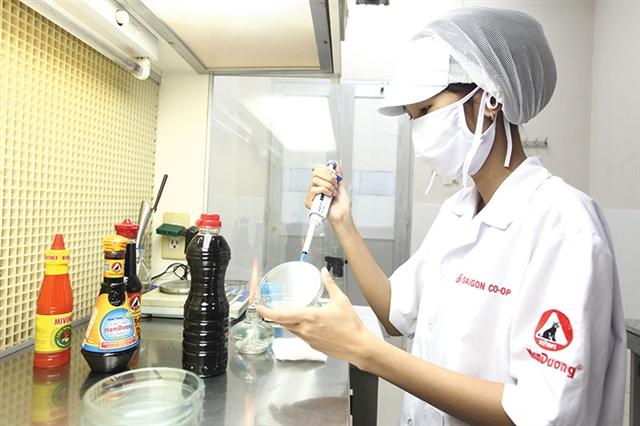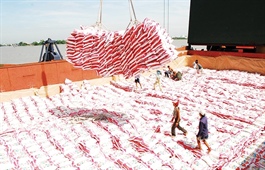Fish sauce producers in a tight spot
Fish sauce producers in a tight spot
Traditional fish sauce is one of the most typical components in Vietnamese cuisine and while its nutritional value has been analysed thoroughly, getting EU customers to consume it more regularly remains a challenge. With the domestic industry declining in the last few years, manufacturers and institutions are yearning for solutions to promote their favourite spice abroad.

Local fish sauce producers have been declining, mainly due to challenges in supplies and regional competition
|
With the United Kingdom soon leaving the European Union, chef Tran Van Bach’s hopes of acquiring flavourful and affordable Vietnamese fish sauce seem shattered, at least until a new trade agreement is agreed on.
Bach said he likes the taste of Vietnamese fish sauce but still buys Thai squid-based sauce for cooking as it is cheaper. Living in Europe for 40 years, Bach has seen how fish sauce has been developing on the other side of the ocean. “Thai fish sauce has been here for a long time, and versions from Vietnam just appeared a few years ago,” Bach explained.
The first Vietnamese fish sauce bottles were officially exported to Europe in 1998 after Hung Thanh on the southern offshore Phu Quoc Island and some other manufacturers were granted the EU’s certification for food safety and hygiene.
Market researcher Euromonitor estimates that the market for the tasty dip sauce is worth about $4.5 billion, with an annual growth rate of about 4.7 per cent in the last five years.
However, local producers so far have not been able to conquer the overseas market, although more and more Europeans begun to know about Vietnamese fish sauce through newspapers, the internet, and visits to Vietnam. Since 2013, the origin name of fish sauce coming from Phu Quoc Island has been protected in all current EU member states, yet even this special legal recognition could not help to gain a larger market share so far, mostly because of a lack of market research by suppliers and consumption habits.
Among the priorities that Bach listed to improve his favourite fish sauce’s market penetration, packaging and labelling are not suitable for European consumers. Some bottles come with volumes of up to 1.65 litres, which is too large for infrequent use. Since most Europeans only use fish sauce as a food seasoning from time to time, smaller containers seem more reasonable.
Consumers may also be set off by confusing labels. Bach said that, instead of using unattractive and overloaded labels, they should simply state the content with phrases like “Vietnamese fish sauce” or “Phu Quoc fish sauce”.
Production barriers
In addition to the difficulties of establishing a firm foothold across the ocean, domestic producers also have to overcome other hurdles. As such, the exhaustion of locally-sourced raw materials presents challenges. Since 2013, Phu Quoc’s overall production decreased due to a lack of anchovies, while Chinese traders have also been interfering with local supply lines. As a result, the price of fresh anchovies skyrocketed from around VND16,000 (70 US cents) during 2017-2018 to up to VND40,000 ($1.75).
Local fish sauce maker Long Phung from Phu Quoc Island’s An Thoi said, “There are on only a few dozen producers of fish sauce left in the commune.”
In early September, Phung had to reduce his production by 40 anchovy barrels after the government declared the island to a special economic zone. The same policy also left another fish sauce producer close to Phung’s house no choice but to sell his factory for around VND800 billion ($35 million).
According to Ho Kim Lien, chairwoman of the Phu Quoc Fish Sauce Association, there are 58 fish sauce houses on the island, producing 25-30 million litres per year, which account for about a quarter of the nations’ entire production.
“Phu Quoc’s variety has been exported to more than 30 countries, with the main markets being the EU, the United States, Japan, and South Korea, with an output of about five million litres per year,” Lien said. “Payment transactions and high discounts are the biggest issues for fish sauce makers.”
One of the common payment methods – letter of credit, a payment mechanism used in international trade to provide an economic guarantee from a creditworthy bank to an exporter of goods – presents a tough challenge for local fish sauce producers. Only one tiny error, such as a spelling mistake or incorrectly placed comma, may be enough for the customer and the bank to decline payments.
The fact that more and more fish sauce makers do not want to continue with their business has become a huge problem for the industry. Data from the Agro Processing and Market Development Authority (AgroTrade) under the Ministry of Agriculture and Rural Development shows that the current processing capacity for traditional fish sauce lies at about 103 million litres per year, while the maximum output could be around 273 million litres.
The process of making traditional fish sauce is unique and hygienic, but producers face difficulties in consumption, especially when it comes to exports. Although Vietnam produces around 170 million litres of all kinds, its main consumers are domestic ones.
Meanwhile famous Thai competitors’ brands such as Golden Boy, MegaChef, and Squid are bolstering their presence in the European market – an opportunity that Vietnamese producers have yet to latch on to.
Thailand has risen to become a market with a clear fish sauce surplus, exporting goods worth around $70 million per year thanks to the consistency in goals and policies which made it possible to establish its export brands.
One reason why Thai companies are more successful than their Vietnamese counterparts lies in their government’s incentives offered to local producers. As such, Thai makers are exempted from paying the corporate income tax for five years as well as the machinery and material import tax when they engage in exports, as per the country’s 2015 Investment Promotion Act.
According to AgroTrade’s deputy director Le Thanh Hoa, the prerequisite for increasing exports to the EU is meeting food safety standards, testing plants and animals, and monitoring processing. In Hoa’s opinion, Vietnamese fish sauce can still regain large shares in major markets, such as Europe and the US.
“The fact that Thailand’s yearly fish sauce output is worth around $300 million per year is, on the one hand, mostly due to the government’s efforts in promoting consensus from global organisations for the establishment of industry standards. On the other hand, these international standards for domestic producers are also closely monitored,” Hoa explained.
Hoa foresees that the recently effective EU-Vietnam Free Trade Agreement (EVFTA) presents a great opportunity for Vietnamese fish sauce as trade tariffs for this product will be dramatically reduced.
Although the cost of promoting it in the EU is higher than for other markets, producers can compensate by selling directly to supermarkets without any discounts but with a shorter payment cycle.
Businesses in need can register with AgroTrade, which is responsible for seafood exports to the EU, including steps like product inspection and code issuance.
Possible solutions
Even before the EVFTA began to open new doors, traditional fish sauce makers have been attempting to bring their products into modern distribution channels such as supermarkets and convenience stores. In addition, the attractiveness of the local industry has lured in large enterprises and their brands such as Unilever’s Knorr Phu Quoc, Acecook’s De Nhat, and ICP’s 584 Nha Trang.
Amid the complications of the current pandemic, many Vietnamese groups have set their focus on digitalisation and increased efforts to promote traditional fish sauce through online media to attract global customers and inform them about the production process and quality standards of their products.
Market researcher Nielsen says that despite this year’s complications, the Vietnamese spice industry will maintain a growth rate of about 25-32 per cent over the next two years, of which fish sauce is the most competitive item.
Tran Huu Hien, CEO of Bay Hong Hanh Ltd., said that his company is preparing to bring its fish sauce to international trading floors by 2021. “While we made sure our quality is up to par, the price remains an important factor for success,” Hien said.
Meanwhile, Link Nature Power JSC’s (LNP) founder Le Ba Linh said that after selling fish sauce on Amazon for two years, the company’s high-protein variety Ma Mi has risen to the top of the best-selling products in this channel. LNP sold over 18,000 products to global consumers, even surpassing Thai competitors in April and May.
“LNP’s products are mainly exported to Canada and the US,” Linh said, adding that she still thinks that Thai companies can outrun her by selling more than 1,000 containers per month.
According to Linh, while Thais also produce fish sauce, the scale is not as large as it could be, and the quality of Vietnamese equivalents remains higher.
























